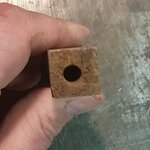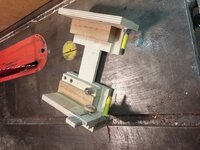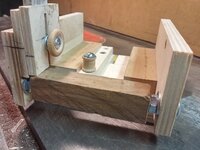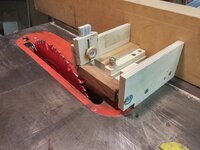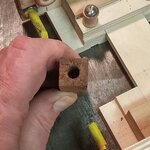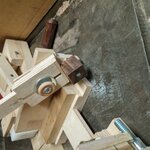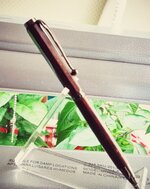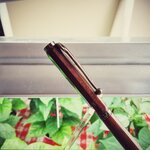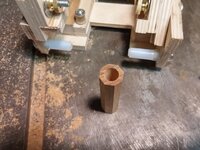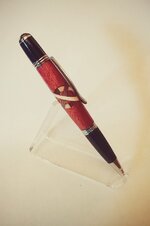OK I'm trying to up my game with more complicated Celtic Knots.
I kind of realize that if the hole is not perfectly square and in the middle of the segmented blank that the knot will be off so I've been working out a way to re-square the blank in relation to the hole after its been drilled. I don't have a great setup to drill blanks but it works fine for pens where being off a 1/16 to an 1/8th at the other end doesn't make a difference.
To Fix this I came up with this.
It reindexes the blank to the hole so it came be re run through the table saw. The first pic of the blank shows it being off and the second after I ran it through the jig. Not this is done before you glue in the tube.
To mount the blank you need to use short sections of your tube and your bushing that fit on the 1/4" bolts at each end. For this demo I didn't have my tubing cutter handy so I just wrapped a bit of tape around them to snug it up. If I do this a lot I would probably just turn some custom bushing for each hole size.
You index it with the upper "slide" and as you cut you rotate the blank a quarter turn indexing off the fresh cut.
It took off a 1/16th to nothing on all sides. The blank is from home milled lumber scraps from my Fathers stash and its a light 3/4" of an inch.
I'll try to do a video tonight if I can set it up. I finished late last night and the pics where the best I could do. With a perfectly square and centered blank I can see doing inlays with multiple strips of wood not laminated but side by side.
So I'm I just over engineering this (I started College as an Engineer and got one son through the program) or I'm I just crazy that I need this kind of precision. :befuddled:
Also if I modify the indexer you could use this to knock the corners off blanks. If I could come up with a way to add an indexing wheel to this you could make blanks of any number of sides.
I kind of realize that if the hole is not perfectly square and in the middle of the segmented blank that the knot will be off so I've been working out a way to re-square the blank in relation to the hole after its been drilled. I don't have a great setup to drill blanks but it works fine for pens where being off a 1/16 to an 1/8th at the other end doesn't make a difference.
To Fix this I came up with this.
It reindexes the blank to the hole so it came be re run through the table saw. The first pic of the blank shows it being off and the second after I ran it through the jig. Not this is done before you glue in the tube.
To mount the blank you need to use short sections of your tube and your bushing that fit on the 1/4" bolts at each end. For this demo I didn't have my tubing cutter handy so I just wrapped a bit of tape around them to snug it up. If I do this a lot I would probably just turn some custom bushing for each hole size.
You index it with the upper "slide" and as you cut you rotate the blank a quarter turn indexing off the fresh cut.
It took off a 1/16th to nothing on all sides. The blank is from home milled lumber scraps from my Fathers stash and its a light 3/4" of an inch.
I'll try to do a video tonight if I can set it up. I finished late last night and the pics where the best I could do. With a perfectly square and centered blank I can see doing inlays with multiple strips of wood not laminated but side by side.
So I'm I just over engineering this (I started College as an Engineer and got one son through the program) or I'm I just crazy that I need this kind of precision. :befuddled:
Also if I modify the indexer you could use this to knock the corners off blanks. If I could come up with a way to add an indexing wheel to this you could make blanks of any number of sides.

